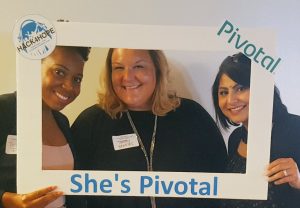
I was at a conference last week where everyone was doing some interesting things with blockchain technology. This is the not-so-secret sauce behind Bitcoin: a transaction log that is verifiable and can be synchronized across distributed servers and still handle multiple trust relationships, where chargebacks can’t happen and where the crypto is strong enough to have banks and other financial institutions spending millions of dollars supporting dozens of startups.
I have written before about blockchain tech for IBM’s SecurityIntelligence blog here, but what got me interested about the conference was how practical blockchain implementations have been and will be. This is especially true in changes to the world of supply chains, where goods move across the globe under a variety of incomplete and error-prone tracking circumstances.
Indeed, at the conference I saw lots of blockchain apps that related to supply chains and had almost nothing to do with cryptocurrencies. This is an industry that is ripe for change. As one analyst has written, many supply chains have data quality issues and automation has failed to deliver significant productivity gains. That could change with these new apps.
For example, there is a company called Everledger.io. The idea is to attach a unique digital signature to each and every diamond that is traded on the various international exchanges. This signature can be immediately verified with the actual item itself – like the way a checksum can be used to verify if a digital file has been altered – to ensure that the diamond hasn’t been tampered with or substituted. So far they have been able to track close to a million diamonds in this fashion. According to insurers, about seven percent of the world’s diamonds are fraudulent in one way or another. Last fall, data from the Gemological Institute of America, the main diamond industry certification body was altered by hackers.
We are still in early days, but you can see there are lots of other applications to help detect when counterfeit goods enter a supply chain that are ripe for blockchain applications. Sending prescription drugs around the world is another high-value application that several teams are working on blockchain apps.
One FedEx manager was on a panel where they spoke about how they need new technology for managing their supply chain. “The immutability of the transaction is important for us: are you who you say you are, and are you shipping what you say you are shipping?” They spend a lot on insurance and it would be nice if they could leverage blockchain tech to prove that a package actually did make it to the final destination, with something other than an illegible signature.
While they can track a package from when it leaves your door through their shipment network, that only works if they have control over the shipment from end-to-end. That isn’t always the case, and especially internationally where it can be more cost-effective if they can hand off a package to another shipper. The panel also brought up an interesting question, as to what constitutes a delivery address, with one of them holding up his phone, saying how he wants to be able to deliver something right to where he is at the moment. That has a lot of appeal to me, as I recall how many hours I have spent trying to find a package delivery person when I stepped out of my office for a moment.
Also speaking was a representative of Chattanooga-based Dynamo, a new accelerator for supply chain ventures. They are funding several blockchain-related startups. “It isn’t just about saving money with these kinds of businesses, but about finding opportunities to expand commerce.”
The conference started off with a speech from Brian Behlendorf, who is now in charge of the hyperledger project that is part of the Linux Foundation. He has been around the tech industry for a long time, putting up Wired magazine’s early website and developing numerous open source projects. The idea behind hyperledger is to have an open source project that can be used in a number of blockchain circumstances. Think of what the Apache programmers did for web servers back decades ago: the same thing will be attempted with having a set of protocols and standard infrastructure to build blockchain apps on top of with hyperledger.
Before the conference took place, a pre-conference hackathon was held and more than a dozen teams and 50 people participated to win the top prize of $20k. The winners included college students, which should give you an idea of how quickly blockchain is evolving. Unlike many hackathons where the winners get to pose with an oversize check, in this case the winning teams’ prize money was preloaded in bitcoin on a special cryptokey, which was quite fitting. The first place finishers wrote an app to eliminate ID fraud, using blockchain to encrypt and validate who you actually are.
Blockchain isn’t just all about the supply chain: the banks are getting involved too. A private effort from R3 has more than 40 financial services supporters to try to create standards for distributed ledgers. Barclays has more than 45 Bitcoin-related projects. Deloitte has a group based in Toronto doing cryptocurrency and blockchain consulting. A Berlin neighborhood has dozens of retailers who accept bitcoins. Finally, there are other currencies that are gaining traction, including Ethereum and Dash.org, that attempt to improve upon the original bitcoin specifications and further fueling blockchain interest.
It looks like there will lots of blockchain-related news in the coming months.


 Last month’s
Last month’s  For this review in Network World,
For this review in Network World,

 Oh no, not another startup business strategy book! But
Oh no, not another startup business strategy book! But